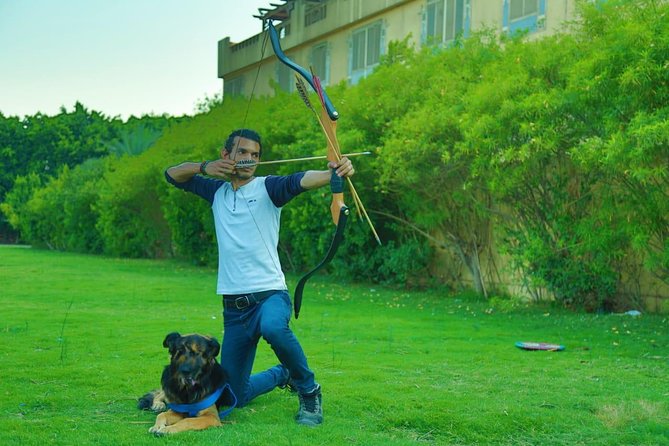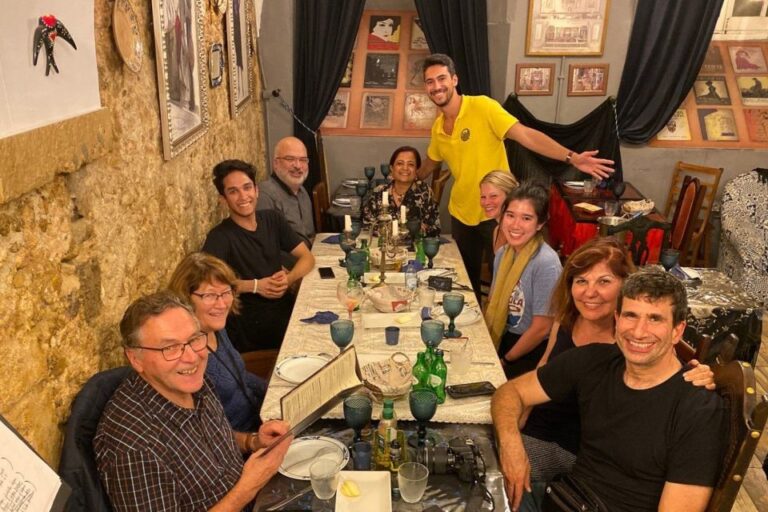Traditional Archery Arts
In the world of archery, the bow and arrow stand as symbols of tradition, precision, and cultural heritage. As enthusiasts draw back their bows, they are not just aiming at targets but also connecting with centuries of history and craftsmanship.
The art of traditional archery holds within its grasp a blend of skill, patience, and reverence for the past. Join this exploration of a timeless discipline that continues to fascinate and inspire individuals worldwide, offering a glimpse into a world where artistry meets athleticism in a harmonious blend.
Key Points
- Traditional archery embodies centuries of historical connections and heritage.
- Mastery requires precision, focus on form, and mental acuity.
- Essential gear includes wooden bows, arrows, quivers, gloves, and arm guards.
- Cultural significance reflects values and beliefs, crucial for preserving traditions.
Here's some more nearby activities we've reviewed
History of Traditional Archery
Delving into the rich tapestry of the past, traditional archery unveils a captivating history that spans centuries of human ingenuity and skillful precision. The evolution of archery, marked by technological advancements, showcases how this ancient art form has adapted over time while maintaining its core essence. From the early handcrafted bows to the development of more sophisticated materials and designs, each era brought new challenges and innovations to the world of archery.
Beyond its technical evolution, traditional archery holds significant cultural importance worldwide. It serves as a means of historical preservation, connecting present-day enthusiasts to their roots and heritage. The practice of traditional archery not only honors the past but also keeps alive the values and skills that have been passed down through generations.
Types of Traditional Bows

Exploring the diverse world of traditional archery, one encounters an array of fascinating types of traditional bows, each with its own unique characteristics and historical significance. Bow craftsmanship plays a crucial role in the design and functionality of these bows.
From the elegant longbows used by English archers to the powerful recurve bows favored by many Asian cultures, each type showcases the skill and artistry of its makers. Traditional bows aren’t only tools for hunting or target practice but also symbols of cultural heritage and tradition.
Engaging in target practice with these bows allows enthusiasts to connect with ancient archery techniques and experience the thrill of mastering a timeless skill passed down through generations.
Traditional Archery Techniques
Mastering traditional archery techniques involves perfecting the art of drawing and releasing the bowstring with precision and control. To excel in archery competitions, archers must focus on their form, breath control, and mental acuity.
Archery mindfulness is crucial, requiring archers to be fully present in the moment, attuned to their surroundings, and centered on the target. Maintaining a calm and focused mind while executing each shot is key to success.
Importance of Form and Posture
Moving from mastering traditional archery techniques, the focus now shifts to the importance of maintaining proper form and posture in archery practice. Proper form and posture are crucial in traditional archery for various reasons.
Firstly, they improve accuracy by ensuring consistent shooting technique. When an archer maintains the correct posture, it helps in aligning the body correctly with the target, leading to more precise shots.
Secondly, proper form and posture reduce the risk of injuries by distributing the strain evenly across the body. By keeping the body in the correct position, archers can prevent muscle strain and other physical issues that may arise from incorrect alignment.
Traditional Archery Equipment
Traditional archery enthusiasts rely on a specific set of equipment to hone their skills and excel in the sport. When it comes to traditional archery gear, here are five essential items they use:
- Traditional Bow: The heart of traditional archery, typically made of wood or bamboo.
- Arrows: Wooden arrows fletched with feathers for accuracy.
- Quiver: A holder for arrows, often made of leather or canvas.
- Glove or Finger Tab: To protect the fingers when drawing the bowstring.
- Arm Guard: Shields the arm from the bowstring upon release.
These items are crucial for traditional archers, whether they’re practicing in their backyard or competing in traditional archery competitions.
Role of Traditional Archery in Culture
In exploring the cultural significance of traditional archery, one uncovers a rich tapestry woven with historical traditions and societal values. Traditional archery holds immense cultural significance, deeply rooted in historical practices that have been passed down through generations.
It serves as more than just a sport or hunting method; it embodies a connection to the past, reflecting the values and beliefs of different societies. The rituals, techniques, and equipment used in traditional archery all contribute to its historical importance.
Through participating in this ancient art, individuals not only hone their skills but also engage with a tradition that has shaped cultures worldwide. The cultural significance of traditional archery continues to endure, reminding us of our shared human history and the importance of preserving these practices for future generations.
Modern Applications of Traditional Archery
Exploring the fusion of ancient techniques with modern innovation, practitioners of traditional archery are discovering new and exciting applications in today’s diverse contexts. Incorporating modern technology has revolutionized the sport, allowing archers to enhance their skills and precision in ways never before possible.
Target shooting has evolved with the use of advanced equipment like laser sights and digital scoring systems, making competitions more accurate and engaging. Plus, virtual reality simulations provide archers with realistic practice scenarios without leaving the comfort of their homes.
Some archery schools now offer online coaching sessions, enabling students to receive personalized instruction from experts worldwide. These advancements not only preserve the traditions of archery but also propel the sport into the future.
Here's a few more nearby tours and experiences we have reviewed.
- Private Arrival Transfer: From Geneva Airport to Yvoire, France
- Private Transfer: Zurich Airport ZRH to Zurich in Luxury Van
- Swiss Knife Valley E-Bike Tour & Lake Lucerne Cruise
- Discover Lugano in 60 Minutes With a Local
- Lucerne Private Walking Tour With a Castle Visit!
- Private Transfer From Basel City to Zurich City
Common questions
What Are the Benefits of Practicing Traditional Archery for Physical and Mental Health?
Engaging in physical fitness routines like traditional archery offers a range of benefits. It enhances strength, coordination, and focus, contributing to improved physical and mental health. Plus, the meditative nature of archery can serve as effective stress relief.
How Can One Find a Reputable Traditional Archery Instructor or School to Learn From?
When looking for a reputable traditional archery instructor or school, you can benefit from finding mentors through community recommendations and exploring online resources for workshop opportunities. These avenues offer valuable insights and opportunities for growth.
Are There Any Specific Traditional Archery Competitions or Events That Enthusiasts Can Participate In?
Traditional archery enthusiasts can participate in various traditional archery tournaments showcasing skill and precision. These events provide a platform for individuals to showcase ancient archery techniques and compete with like-minded individuals, fostering a sense of community and camaraderie.
What Are Some Common Misconceptions About Traditional Archery That Beginners Should Be Aware Of?
Beginners should be aware of common misconceptions about traditional archery. Myth debunking helps clarify techniques. Historical context meets modern influences. Understanding these aspects enhances the learning journey and fosters a deeper appreciation for the sport.
How Can Traditional Archery Be Adapted for Individuals With Physical Disabilities or Limitations?
Adaptive techniques and inclusive programs cater to individuals with physical limitations in traditional archery. Modified techniques and assistive equipment enable participation, fostering a welcoming environment. These initiatives ensure that everyone can enjoy the sport regardless of their abilities.
Here's more of our most recent tour reviews happening neaby
- Bern Private Tour: Zermatt Village & Glacier Paradise
- Lucerne: Interlaken and Grindelwald Swiss Alps Day Trip
- Rafting in Interlaken With Return Transfer From Lucerne
- Vacation Photographer in Zug
- From Lucerne: Day Trip to Grindelwald and Interlaken
- Mount Rigi Guided Hike From Lucerne
- Leukerbad Resorts to Geneva Airport GVA – Departure Transfer
- Basel Airport Transfer: EuroAirport (BSL MLH EAP) to Basel in Business Car
- From Zurich to The Rhine Falls
- Private Photo Session With a Local Photographer in Zug
- Lausanne: Scavenger Hunt and Self-Guided City Walking Tour
Last Words
To sum it up, traditional archery is more than just a sport – it’s a timeless art form that connects individuals to history, culture, and nature.
From the ancient civilizations that first mastered the bow and arrow to modern-day enthusiasts who continue to practice its techniques, traditional archery embodies skill, precision, and a deep appreciation for craftsmanship.
Whether you’re a seasoned archer or a beginner looking to learn, the world of traditional archery offers a unique and rewarding experience for all.





